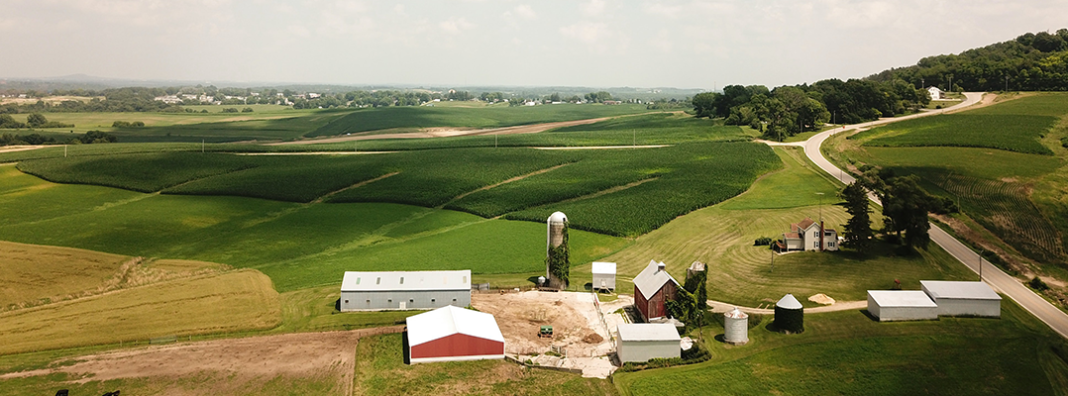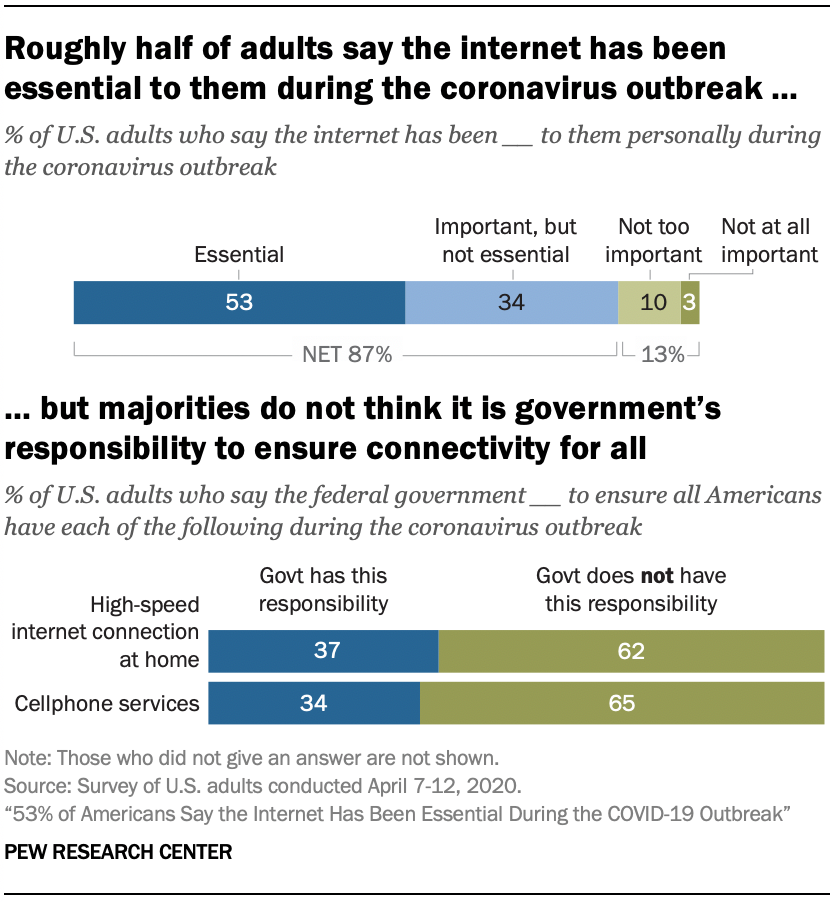
This post is the second in a series of four posts, which first explores the current infrastructure bills, diagnoses the problem inherent in the digital divide, explores broadband as an infrastructure problem, and finally lays out an algorithm for action.
In just two decades, high-speed Internet access has gone from a novelty to near ubiquity, yet still some are left unconnected. For years, federal and local leaders have sought to plug this digital divide by supporting infrastructure buildout. The ongoing pandemic has served to heighten the concern over broadband access, as more Americans than ever have shifted to working from home and healthcare providers have shifted to virtual appointments.
As policymakers consider measures to bridge this divide, it is essential to know that,
- Unconnected individuals typically have low educational attainment, low income, are elderly or are disabled;
- Two-thirds of those not connected say that lack of interest is the primary reason for being offline; and
- Just this year federal programs began supporting households to offset cost of service.
As the technology has matured, gotten cheaper, and faster, the digital divide has become an increasingly difficult problem to solve. The final post in this series will lay out a plan to tackle the digital divide. Before plans are made, however, the nature of the digital divide needs to be established.
Understanding the unconnected
While it is understood that a sizable chunk of Americans are not connected to the Internet, just how big this group is can vary considerably depending on the source. Pew’s most recent survey from February 2021 suggests about 7 percent of adults in the US aren’t using the Internet. Since there are roughly 255 million adults, by their count, some 18 million people aged 18 and above about the size of the New York City metro area, aren’t using the Internet.
The Census, on the other hand, estimates that 49.9 million people weren’t connected to the Internet by any means in November 2019. Their estimate clocks in at 18.9 percent of the population aged 15 and above, or about 16 percent of all households.
Data from the Federal Communications Commission paints a slightly different picture since their data tracks broadband deployment, and thus speaks to broadband availability. If satellite operators and fixed wireless services are included in the tally, around 102,000 adults in the U.S. cannot access the Internet because service isn’t available to their home. Excluding these technologies, as many estimates often do, just over 17 million people are without an Internet connection to the home.
Data from 2020 is still forthcoming, but the disruption caused by Covid might have acted as a demand shock cajoling laggards to get online. The largest cable and wireline phone providers in the U.S. added 4.9 million Internet subscribers in 2020, compared to 2.6 million in 2019. Overall, broadband subscription rates rose to their highest levels in a decade at the end of 2020, suggesting that the official Census estimates are probably too high.
While there might be disagreement about the size, the characteristics of this group are widely known, as CGO analysis shows. The unconnected tend to have a high school diploma or less education, income with less than $25,000 a year, a disability, or be aged are 65 and up. Minority and rural households also see higher proportional rates of no Internet connection. However, as far as absolute numbers are concerned, the digital divide is still an urban phenomenon since nearly 85 percent of this group is located in a metropolitan region.
Knowing why households remain unconnected should help guide expectations about current policy proposals. Data from the Census Computer and Internet Use survey is below.
The same data is presented below in relative terms.
In the broadest of strokes, we should contrast demand-side issues like cost and interest with supply-side concerns like availability and security. The number of homes that lack access to a service provider has been growing in size over time, but it still ranks especially low, affecting a little over 850,000 households. As the previous post laid out, the infrastructure bills currently under discussion aim to solve this broadband availability gap, which is a small part of the overall problem.
Two groups stand out from the rest. By far, lack of interest is the dominant reason why people aren’t connected at nearly two-thirds. For ease of reference, this group will be called the Internet incalcitrant. Next to that, people aren’t connected because they find the service too expensive. Together these two causes make up 88 percent of the problem. If leaders could help solve these demand-side concerns, much of the digital divide could be gapped.
Digital equity and the digital divide
The driving forces for non-adoption highlight a key difference between the digital divide and the much broader term, digital equity. Equity is a longstanding tradition in the United States and other liberal democracies that strives to allocate resources and opportunities to those in need in order to reach an equal outcome. In a world increasingly dominated by the digital, having Internet service and a computer is only half the battle. Knowledge of how to use these resources is key as well. Digital equity thus includes issues related to access, sometimes called the first-level digital divide, as well as the second-level digital divide, which is related to the use of digital tech.
For two decades, public policy has focused on the first-level digital divide, specifically the broadband availability gap to ensure that individuals have access to digital technologies. Recently, however, Congress has also taken up the issue of digital equity with the Digital Equity Act. In pushing this bill, Senator Murray explained that it “will direct significant new federal investments to help ensure people in our communities have the tools, support, and technologies necessary to take full advantage of a broadband connection when they have access to one.”
Still, broadband equity exists in tension with the choices that the Internet incalcitrant make. In talking through a central goal of public policy in democracies, philosopher Ingrid Robeyns shed light on this little-discussed part of the digital divide,
What is ultimately important is that people have the freedoms or valuable opportunities (capabilities) to lead the kind of lives they want to lead, to do what they want to do and be the person they want to be. Once they effectively have these substantive opportunities, they can choose those options that they value most. For example, every person should have the opportunity to be part of a community and to practice a religion; but if someone prefers to be a hermit or an atheist, they should also have this option.
Importing this thinking to the digital divide, what official stance should federal and state governments take in response to those that have chosen freely not to be online?
A vast majority of those not connected, two-thirds, show a clear preference for not being connected. They have chosen to abstain. Neither access nor price is the limiting factor because they don’t want to be a part of the service. Anne Evans of Naples, Florida explained to The Hustle that there are multiple reasons why she’s not connected: “It’s too impersonal… It’s a machine that doesn’t involve human-to-human contact…I like to stick with my old ways. Not because I’m stubborn — I just like it that way.” Luke Holtschneider, rural development manager for the Missouri Department of Economic Development, repeated a similar narrative to The Missourian. Supporting communities requires that policies take an agnostic view of this group, but in turn, that goal remains in conflict with digital equity which seeks to ensure everyone is educated and has access.
Indeed, the public is less enthusiastic about the project of digital equity. Pew polling from April 2020 found that a majority of Americans (62%) did not think it is the federal government’s responsibility to ensure that all Americans have a high-speed internet connection at home during the COVID-19 outbreak. As one might expect, partisan differences exist. Roughly half of Democrats and independents who lean to the Democratic Party say it is the federal government’s responsibility, while only 20 percent of Republicans and Republican-leaning independents hold this view.
Source: Pew
Moving forward from COVID, broadband public policy will increasingly chase after the Internet incalcitrant. Internet, social media use, and device ownership have all plateaued. Broadband subscription rates rose to their highest levels in a decade at the end of 2020, suggesting even more people went online. Speaking on the unconnected, Pew noted, “The size of this group has changed little over the past four years, despite ongoing government and social service programs to encourage internet adoption in underserved areas.” As such, policy levers aimed to bridge the gap are meeting limits as the marginal value of any program drops.
Supply-side efforts to solve the digital divide
Governments at all levels have largely sought to bridge the digital divide by altering the supply. Local and federal agencies have directly funded new networks, supported key institutions like schools and libraries, and streamlined the regulatory processes to speed up deployment. Built into these policies is the implicit assumption that demand for broadband service will quickly emerge once the facilities are operational. Projects have been funded through one-off programs and through continuing programs.
Until Covid, the American Recovery and Reinvestment Act, colloquially known as the Stimulus, counted as the only time Congress has provided one-off support. In total, $7.2 billion of the act was allocated to extend broadband Internet access, including $2.5 billion for rural communities via the Broadband Infrastructure Program (BIP), which was administered by the Rural Utilities Service (RUS). Research on this program found that broadband adoption did increase in the targeted communities for a couple of years, but didn’t increase economic measurements like median income and employment. Congress also appropriated $4.7 billion to create the Broadband Technology Opportunities Program (BTOP), which was administered by the National Telecommunications and Information Administration (NTIA).
As the table below helps to illustrate, federal agencies provide support for Internet infrastructure development on an ongoing basis. The Universal Service Administrative Company, chartered by the Federal Communications Commission, oversees the Universal Service Fund (USF), which is the largest of these. The USF is supported through a federal Universal Service Fee, which often shows up as a tax on telephone and wireless bills. This fund is then redistributed to schools, libraries, and individuals through a number of programs meant to support communication infrastructure. All told, this program will spend $9 billion in 2021.
While Congress has been debating a larger infrastructure package, the FCC has already put into motion the Rural Digital Opportunity Fund (RDOF), which is funded via USF. As noted in the first post in this series,
RDOF intended to bring “high speed fixed broadband service to rural homes and small businesses that lack it.” At its close in late 2020, $9.2 billion in support was given out to 180 different groups which will bring service to over 5.2 million unserved homes and businesses, almost 99 percent of all locations targeted. Phase II of the auction, which has yet to be announced, has an additional $11.2 billion in support that will be allocated for the same purpose.
Still, this year is slated to be a banner year in broadband spending. At least $22 billion should be headed out the door in 2021, over twice what was dispersed in 2020. Importantly, this figure doesn’t include the $350 billion in emergency funding for eligible state, local, territorial, and Tribal governments to respond to the COVID-19 emergency. States like California, West Virginia, and Missouri, just to name a few, are using these monies to boost their own state broadband programs or begin new programs outright. Even if the larger infrastructure package stalls, broadband funding will look very different after next year.
Previous work of mine reviewed the effectiveness literature detailing the impacts of subsidies on Internet usage, GDP growth, unemployment, firms, and industries. As I cautioned then, leaders need to attend to the specifics of each proposal and what they want to accomplish. The fourth post in this series will offer a detailed course of action for both the states and the federal government.
Demand-side efforts to solve the digital divide
While demand-side efforts are likely to yield the greatest results in bridging the digital divide, no federal program existed to help low-income households with standalone broadband service until late last year.
The budget package passed at the end of 2020 set aside $3.2 billion for a new Emergency Broadband Benefit Program (EBB) administered by the FCC to help families struggling with COVID by giving them $50 per month. Those already enrolled in Lifeline, one of the four major programs at USF, are automatically eligible, but it is also available to families that are eligible for free school lunches, college Pell Grant recipients, and people who have lost jobs or been laid off at any point since this economic crisis began.
The EBB shares some key features with the Lifeline program. Lifeline was originally created in the Reagan era to help low-income people get a phone line, but in 2009, the FCC expanded the program to support wireless phones, and then expanded it again in 2016 to support wireless broadband services. Today, participants can get a $9.25 cut off their monthly bill if they qualify, for a total spending of $2.4 billion in 2020. Both the EBB and Lifeline support families in buying communication services.
Still, Lifeline spends billions each year as it has for decades, but there is very little known about the effectiveness of the program as a means of pulling people out of poverty. Research from the late 1990s when Lifeline still targeted telephones found it did have a positive effect on telephone penetration, but this came with a large price tag. As economists Garbacz and Thompson explained, “program elasticities are extremely small, suggesting that very large expenditure increases per poor household would have little effect on telephone penetration.” Indeed, the GAO has recommended since 2015 that Lifeline needs to be subject to a program evaluation. Policymakers are still making blind decisions since little is known about the effectiveness of the program. The EBB needs to course-correct and ensure better analysis of its programs.
The last time the FCC dove into the topic in 2012, it supported 14 broadband pilot programs to collect data on what policies might overcome the key broadband adoption barriers. The results show just how difficult it is to target non-adopters. In the end, 8,634 new Internet users got connected because of the project, yet, the agency estimated 74,000 households would opt in. Results from surveys conducted before and after the programs reveal the difficulty in getting people connected, as economist Scott Walstein first pointed out. Cost was the most cited reason for not being on the Internet before the program, and yet, participants later said the reduction in price wasn’t a driving factor in getting them online.
Other research confirms the difficulty of getting people connected. As far back as 2007, Seattle recognized that for the disconnected, “Many of these households are not interested in Internet access at any price.” Comcast’s Internet Essentials program stands as the longest-running private version of a supplemental Internet program. Just last year, Rosston and Wallsten found that the program caused roughly 292,000 households to subscribe to broadband service between 2011 and 2015. As they concluded, “we generally do not know how best to entice the remaining broadband non-adopters to connect to broadband.”
The lesson from policymakers is clear. Cost might be a barrier for some, but lowering cost doesn’t get a lot of people newly connected.
Conclusion
For years, leaders funded efforts to plug the broadband availability gap by supporting infrastructure buildout even though lack of infrastructure is a small part of the divide overall at just 4 percent. A bigger chunk of Americans, 21 percent, say that cost is the determining factor. Beginning last year, Congress decided to give families a $50 credit outright.
Both of these causes pale in comparison to the dominant reason for non-adoption, which is lack of relevance at 67 percent. The nature of the problem is key since all too often, leaders underrate important policy details. Few programs in the arsenal can target this group. Getting people online has been much harder than imagined. The next two posts in this series lay the groundwork for better policy in broadband.


